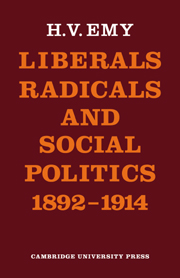Book contents
7 - The Liberals in office 1910–14
Published online by Cambridge University Press: 04 May 2010
Summary
In 1910, contemporaries were agreed that a point of no return had been reached, and from 1910 it was indeed possible to claim that ‘a displacement both of ideas and political power had started’. The budget crystallised the latent divisions between the two major parties. In 1909, J. A. Hobson attributed growing Conservative intransigence to their fears that social reform, financed by the taxation of the unearned increment in the form of heavy direct taxation upon high incomes and property, was to become a continuous Liberal policy rather than a series of isolated acts. With the prospect of an extensive, and expensive, insurance programme ahead of them if they failed to overthrow the Liberals, the Conservatives had little to lose by risking all on fighting the budget. This may have been a shrewd analysis, for J. S. Sandars informed Balfour that Lloyd George was reputedly planning the nationalisation of the railways as well as land nationalisation; accordingly, he suggested the Conservatives fight all the way under the banner ‘ a vote for the budget is a vote for socialism. It would go through the country’.
The crux of the Conservative case lay in their refusal to accept that policies of income redistribution and the state redirection of resources to weak or deprived sectors of the community was, as a primary goal, compatible with the continued functional efficiency of the productive process.
- Type
- Chapter
- Information
- Liberals, Radicals and Social Politics 1892–1914 , pp. 235 - 280Publisher: Cambridge University PressPrint publication year: 1973



